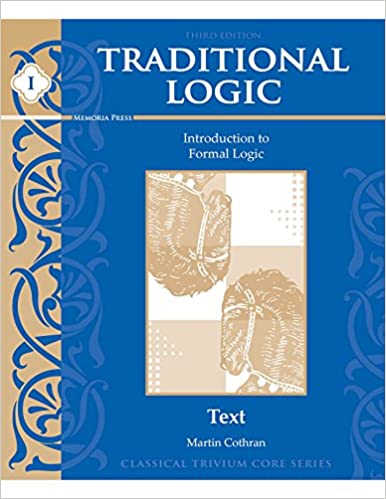

Formal logic is a subject that belongs in every homeschool’s curriculum. Sign up today to learn how to reason, the mechanics of reasoning, and how to get from a premise, or an assumption, to a right conclusion.
How to get the most out of Introduction to Formal Logic with Phillip Campbell:
-
First, read the course details below and purchase the text plus answer key.
-
Prepare a notebook for notetaking and homework.
-
Students begin the course by completing the Reading Assignment in the first module.
-
After the reading is completed, click on the Recording and watch Mr. Campbell's lecture for Class One.
-
Next, students should complete the reading for the week and homework.
-
If you need review, go back and watch the recording again and/or go over the Power Point.
-
Repeat until all 14 classes are complete.
-
There is a final exam with an answer key in the last module. Students are on their honor not to open the answer key.
-
Once the course is completed to the parent's satisfaction, there is a Certificate of Completion at the end to be filled in for your records. Parents should record the final grade in their records. Note that HSC does not provide record keeping services.
- Special Notes: To continue your Logic studies, follow this course with Dr. Nicholson’s Methods of Logic course in the spring 2024 semester.
Total classes: 14
Duration per class: 55 minutes
Prerequisite: None
Suggested grade level: 7th to 9th grade, but anyone who has never had any formal logic training is welcome
Suggested credit: 1 full semester Logic
Instructor: Phillip Campbell
Instructor Email: phicampiii@gmail.com
Course description: This intensive 14-week course will introduce students to the principles of formal logic as presented in the book Traditional Logic: Introduction to Formal Logic by Memoria Press. The aim of formal logic is to teach students how to think properly, focusing on the consistency and process of argumentation (the content of argumentation will be covered in material logic).
Course Outline:
- Week 1: The Concept of a Concept: Simple Apprehension and the act of forming a concept in the mind
- Week 2: Properties of Simple Apprehension: Comprehension and extension, two properties of simple apprehension, demonstrated using the Greek Porphyrian Tree
- Week 3: Words and How we Use Them: Signification, supposition and the different ways we can use words to mean things
- Week 4: The Act of Judgment: Moving beyond simple ideas, we look at what it means to make a judgment and put a statement into logical form
- Week 5: The Four Statements of Logic: The four logical statements, A, I, E, and O and the difference between the quality and quantity of statements.
- Week 6: Relations of Opposition: Contradictory and contrary statements
- Week 7: The Subs: Subcontrary and subaltern statements and the essence of their relations to one another
- Week 8: Distribution: The status of a particular term in regard to its extension
- Week 9: Logical Equivalence: Converting statements through obversion, conversion and contraposition
- Week 10: Deductive Inference: Introduction to reasoning through the use of the syllogism
- Week 11: Rules! Rules! Rules! Terminological rules when dealing with categorical syllogisms
- Week 12: More Rules: Overview of the quantitative rules for categorical syllogisms
- Week 13: Finally...Rules: The qualitative rules for categorical syllogisms.
- Week 14: Review: Review and prep for final to see if you really got any of this!
Course materials: PowerPoint installed on your home computer. Traditional Logic: Introduction to Formal Logic (ISBN-10: 1615388761) by Martin Cothran, the Traditional Logic Student Workbook (ISBN-10: 1547701250), and Traditional Logic Teacher Key (ISBN-10: 1547701242).
Homework: Five to six pages of reading per week coupled with completing exercises provided in the text. Students can self-grade, or give to parents to grade, using the Traditional Logic Teacher Key. Downloadable Final Exam with answer key is also provided. Anticipated workload is three to four hours per week.
- Teacher: Phillip Campbell